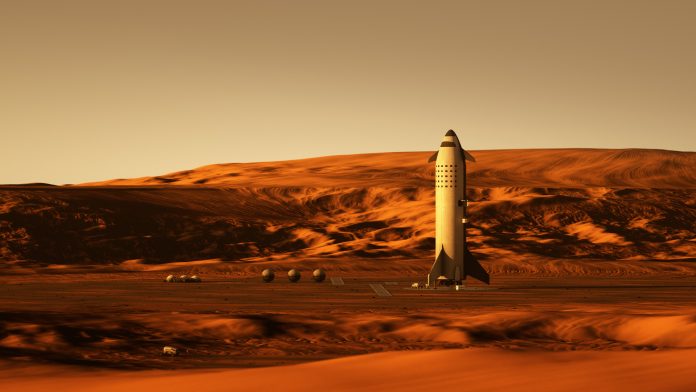Researchers from the Georgia Institute of Technology and their collaborators have created a cutting-edge technique that can produce rocket fuel on Mars, a vital breakthrough that may make bringing astronauts back from the red planet more efficient.
The groundbreaking rocket fuel is developed in a novel bioproduction process that utilises three resources the Martian planet has in abundance – carbon dioxide, sunlight, and frozen water, and would also involve transporting two microbes to Mars. The first microbe would be cyanobacteria (algae), which would take CO2 from the atmosphere and use sunlight to make sugars, which then will be converted using specially engineered E. coli to create the advanced rocket fuel.
The innovative rocket fuel – called 2,3-butanediol – is currently in exitance on Earth and is traditionally employed to create polymers for rubber production. The study’s findings are published in the journal Nature communications.
Intergalactic travel restrictions
Currently, rockets departing for Mars are planned to be fuelled by methane and liquid oxygen (LOX); however, this causes some astronomical issues. Firstly, neither exist on the Martian planet, meaning they would need to be transported all the way from Earth to power a return spacecraft into orbit. In addition to being inefficient, this method is also costly, as carrying the 30 tonnes of methane and LOX required is estimated to cost around $8bn. NASA has proposed a technique to convert carbon dioxide on Mars into LOX, although methane still needs to be brought from Earth.
To overcome this rocket fuel conundrum, the Georgia Tech experts have developed a biotechnology-based in situ resource utilisation (bio-ISRU) strategy that can effectively generate the rocket fuel and the LOX. The state-of-the-art method may help reduce the mission costs of Mars expeditions, generating 44 tonnes of excess clean oxygen that could be employed to support human colonisation.
Nick Kruyer, the first author of the study and a recent PhD recipient from Georgia Tech’s School of Chemical and Biomolecular Engineering (ChBE), said: “Carbon dioxide is one of the only resources available on Mars. Knowing that biology is especially good at converting CO2 into useful products makes it a good fit for creating rocket fuel.”
How is the rocket fuel developed?
The rocket fuel process starts by transporting plastic materials to the red planet that will be fashioned into photobioreactors that will occupy the size of four football fields, which would be used to grow the cyanobacteria through photosynthesis. The cyanobacteria would then be broken down into sugars by enzymes that are then fed to the E. coli to generate rocket fuel, which is then isolated using advanced separation methods.
This neoteric strategy uses 32% less power but weighs three times more than the alternative of shipping methane from Earth and producing oxygen through chemical catalysis; due to gravity on Mars being considerably weaker than on Earth, the team were able to be creative when devising a potential rocket fuel.
Pamela Peralta-Yahya, a corresponding author of the study and an associate professor in the School of Chemistry & Biochemistry, said: “You need a lot less energy for lift-off on Mars, which gave us the flexibility to consider different chemicals that aren’t designed for a rocket launch on Earth. We started to consider ways to take advantage of the planet’s lower gravity and lack of oxygen to create solutions that aren’t relevant for Earth launches.”
Wenting Sun, associate professor in the Daniel Guggenheim School of Aerospace Engineering, commented: “2,3-butanediol has been around for a long time, but we never thought about using it as a propellant. After analysis and preliminary experimental study, we realised that it is actually a good candidate.”
The team are now working to reduce the weight of the bio-ISRU method to make it lighter than the chemical process, such as improving the speed at which cyanobacteria is grown on Mars, which will reduce the size of the photobioreactor, making the payload significantly smaller.
Matthew Realff, who worked on the algae-based process, said: “We also need to perform experiments to demonstrate that cyanobacteria can be grown in Martian conditions. We need to consider the difference in the solar spectrum on Mars both due to the distance from the Sun and lack of atmospheric filtering of the sunlight. High ultraviolet levels could damage the cyanobacteria.”









